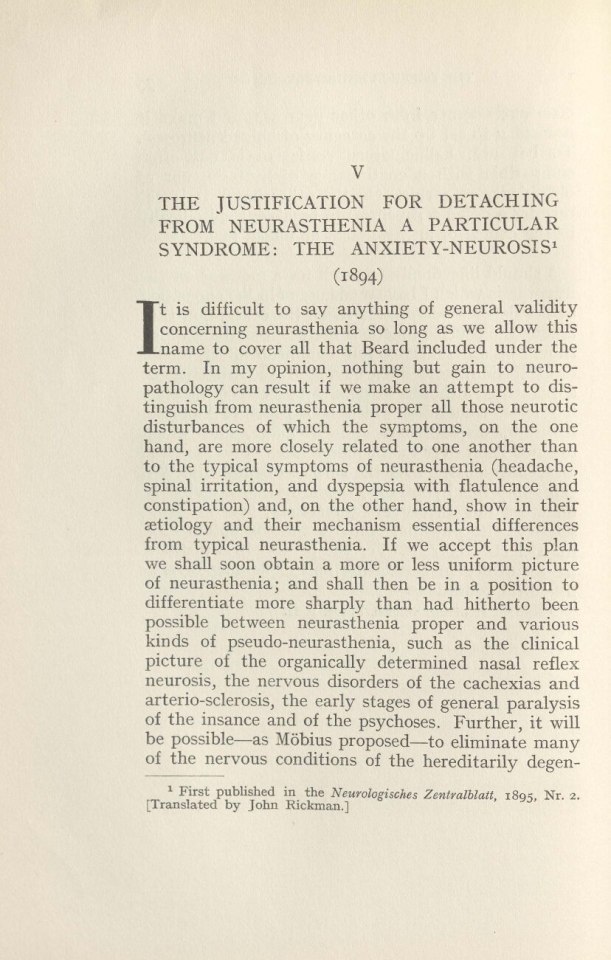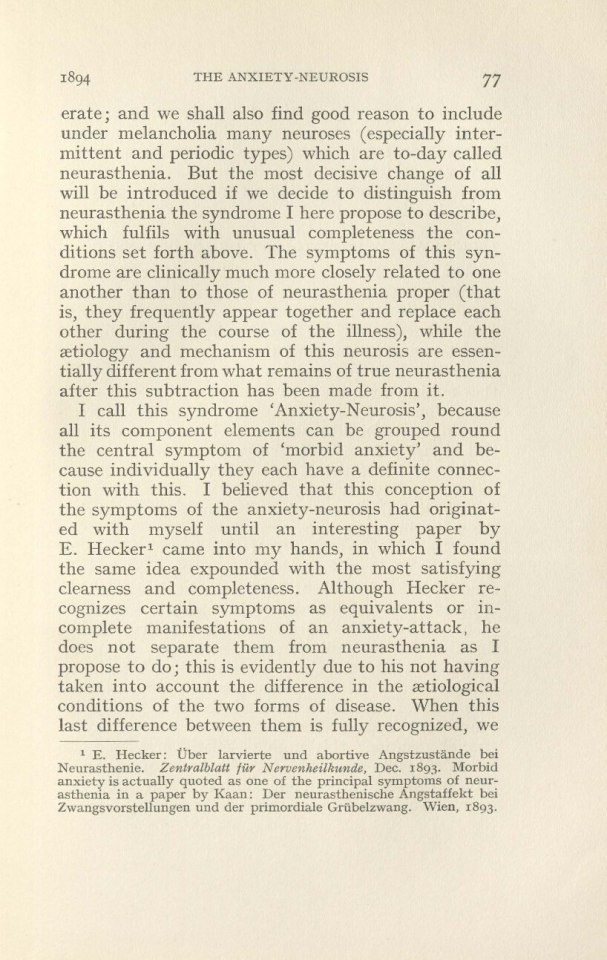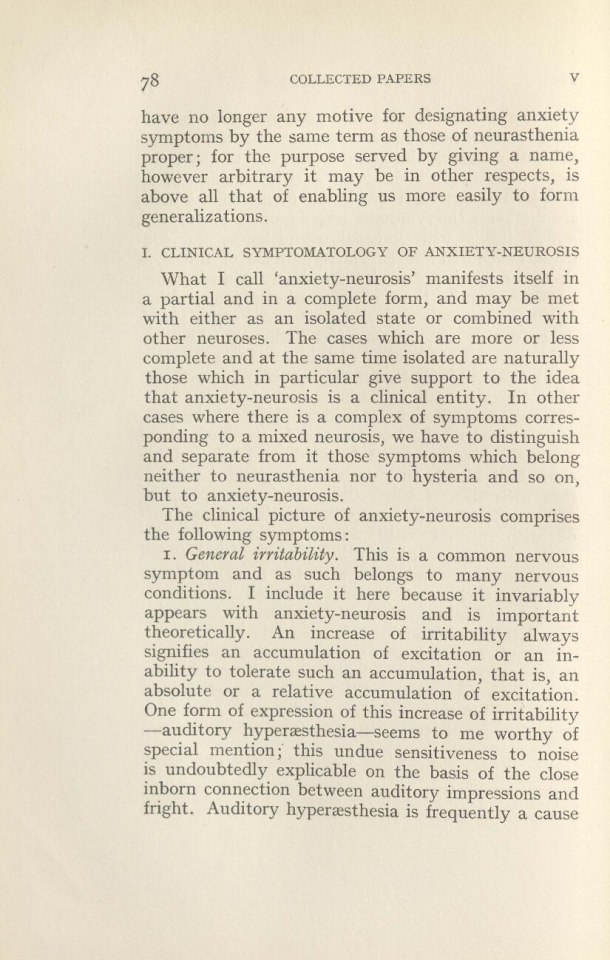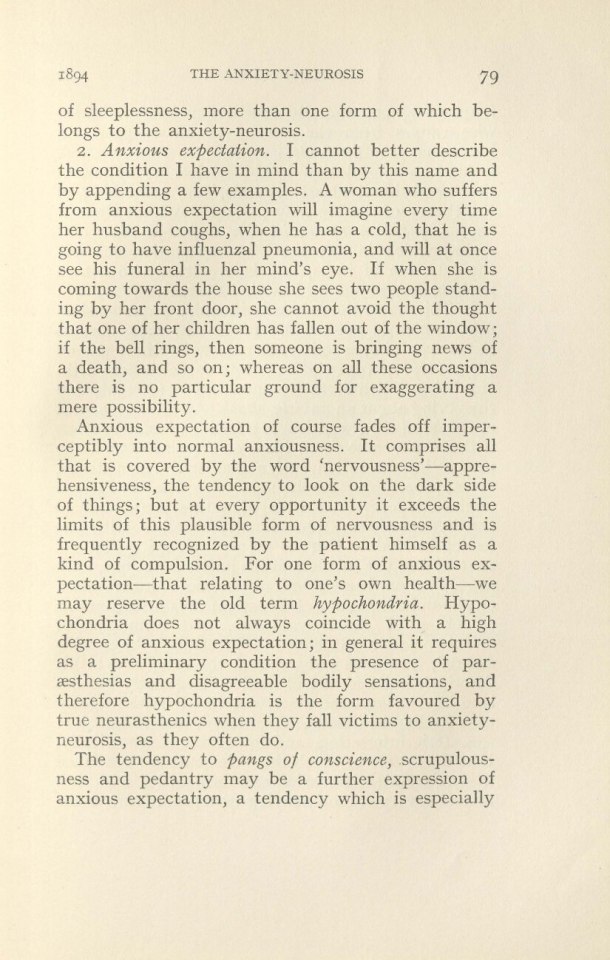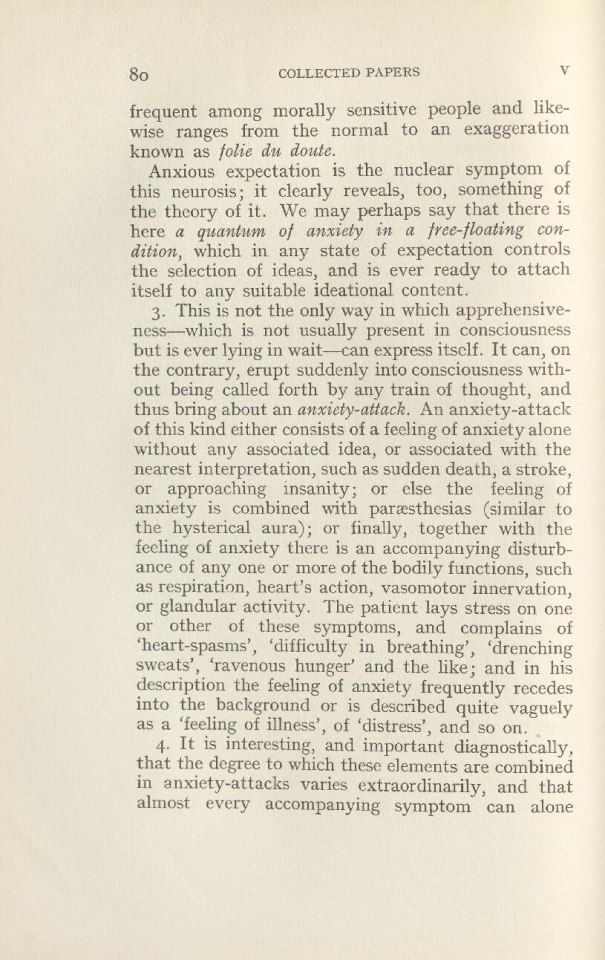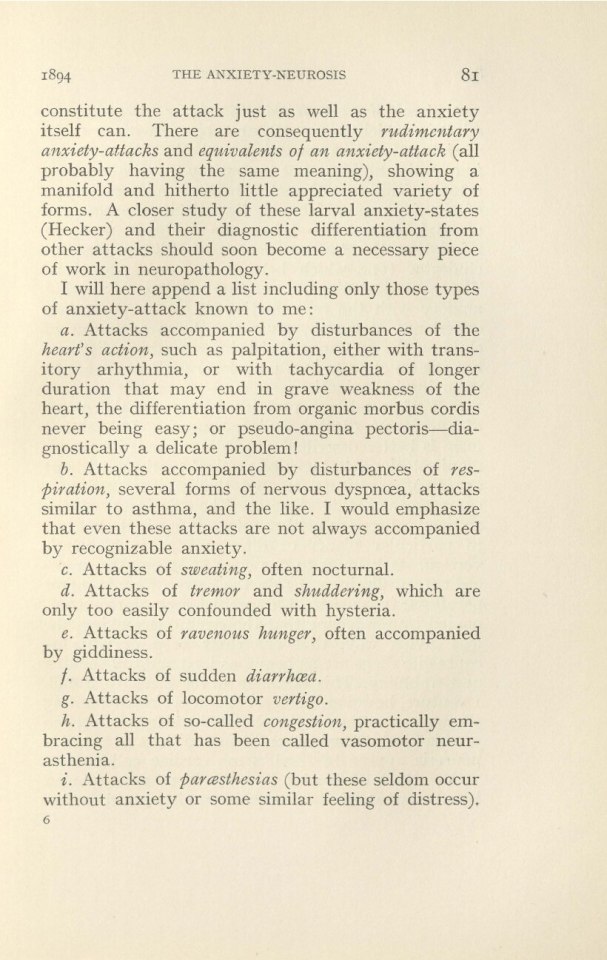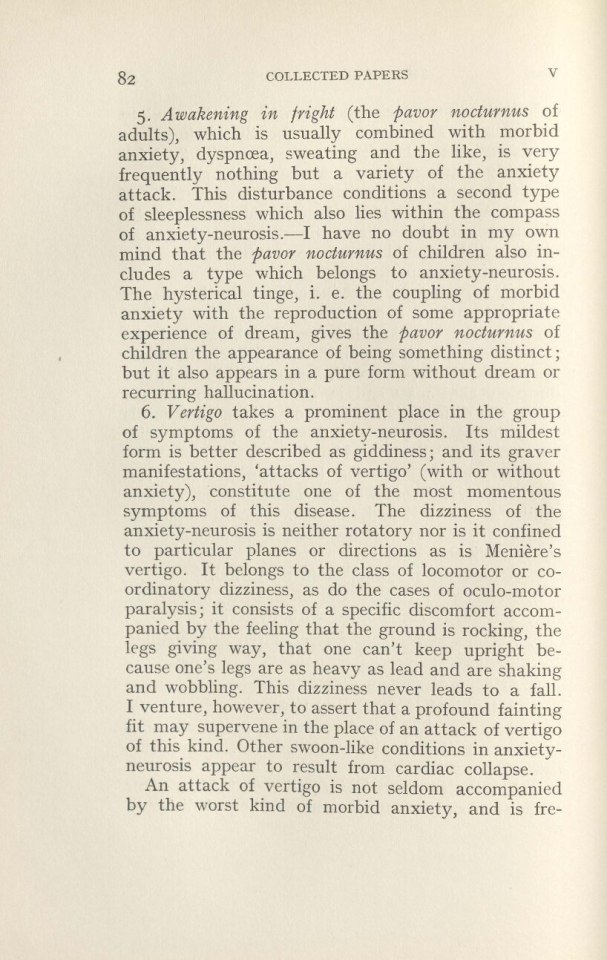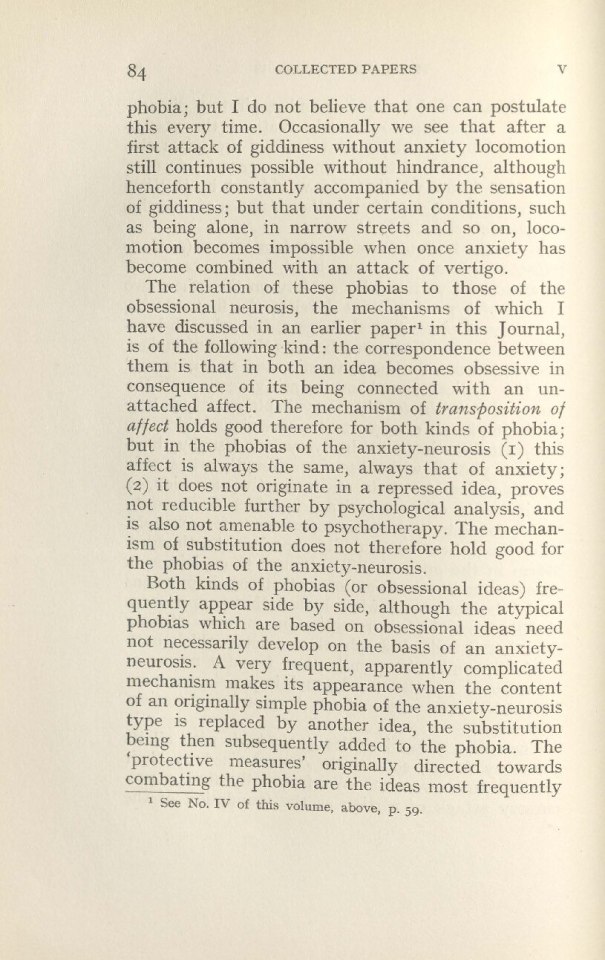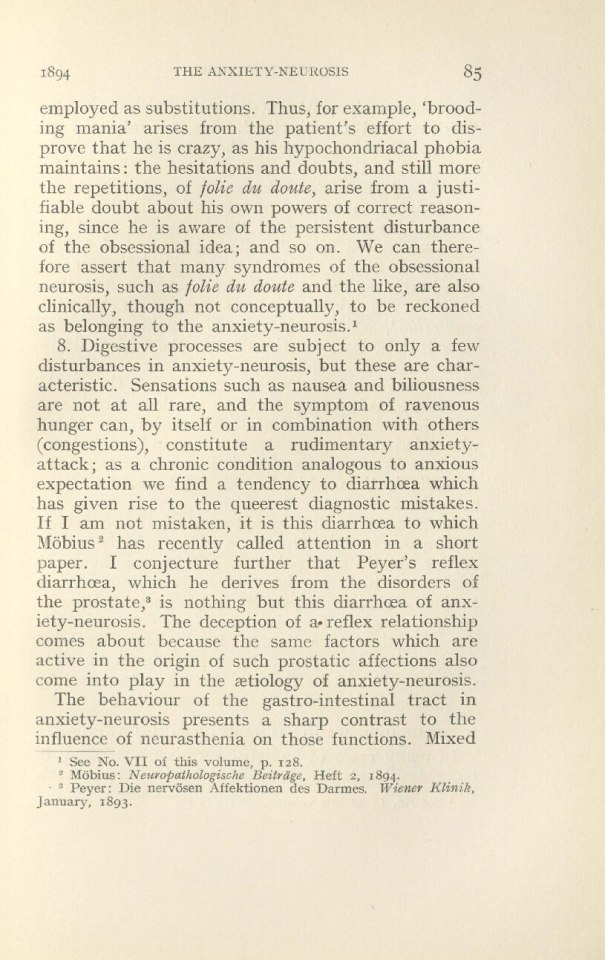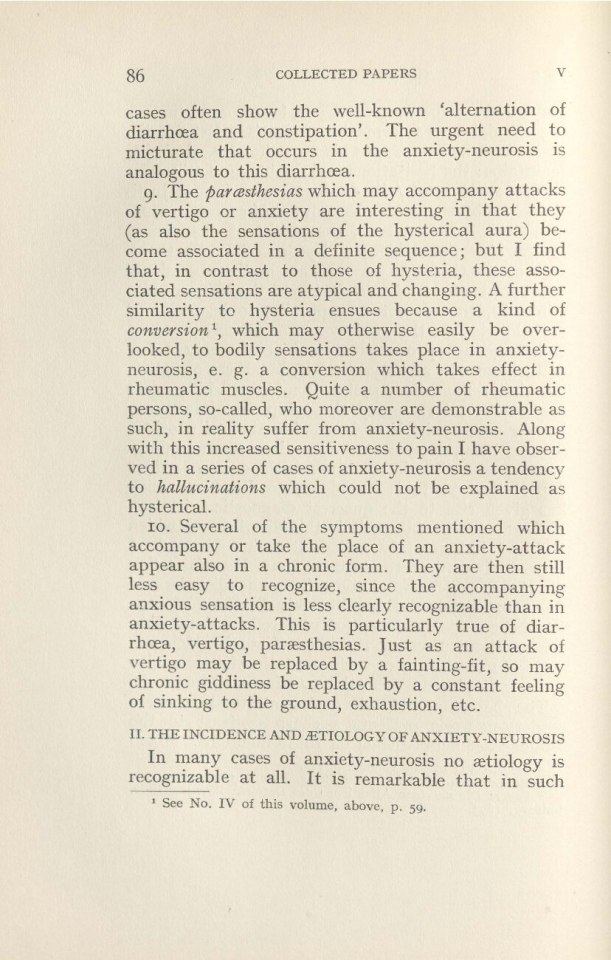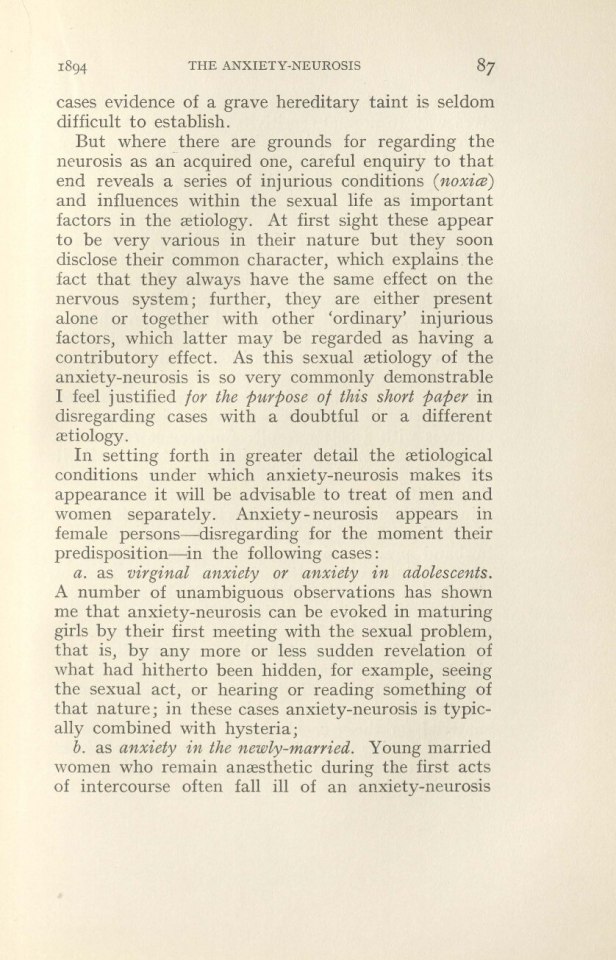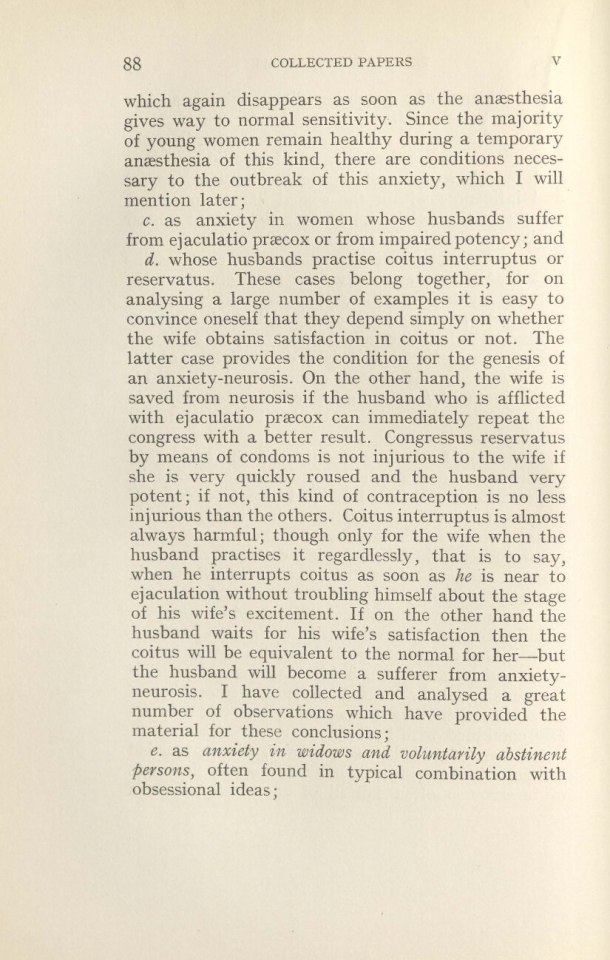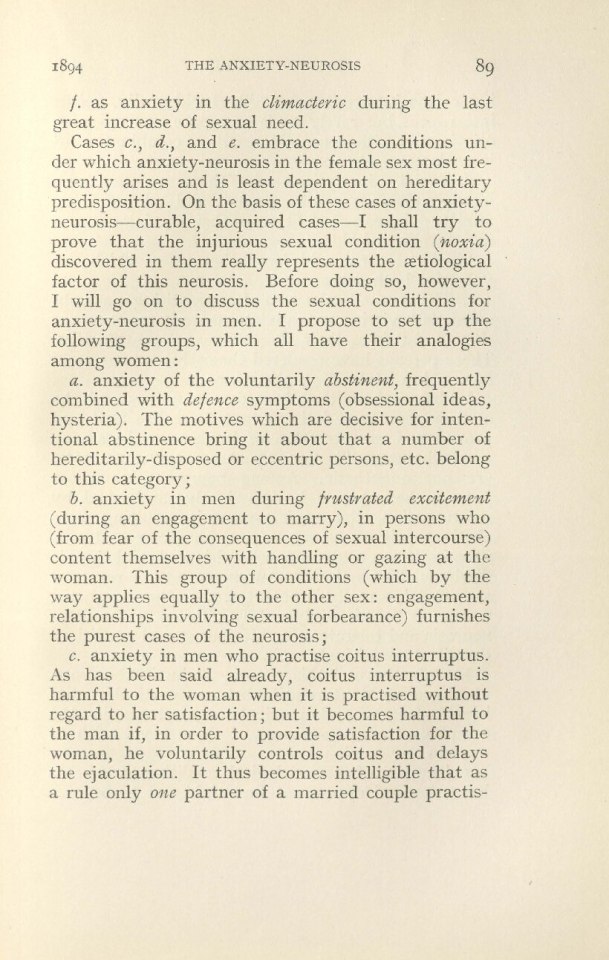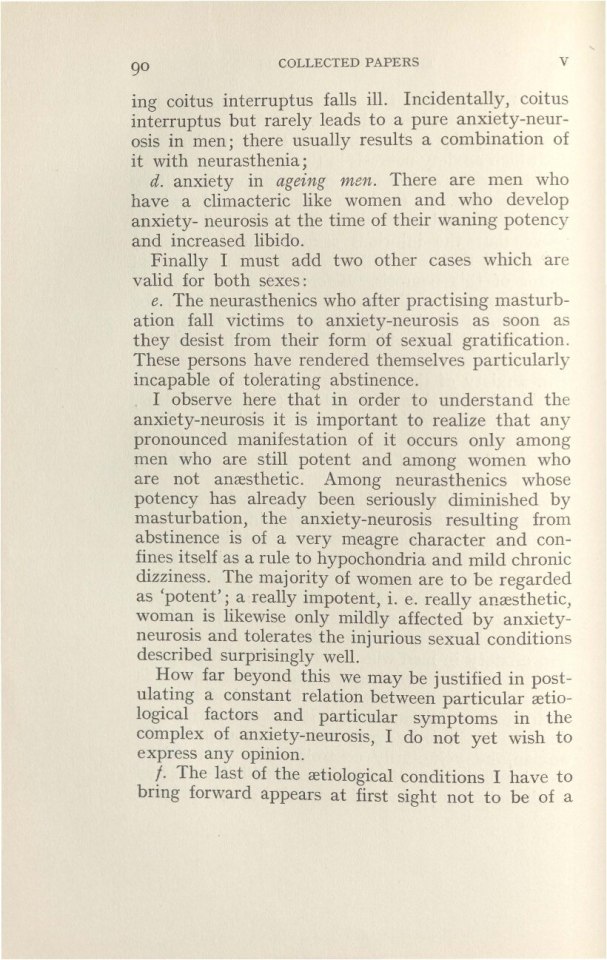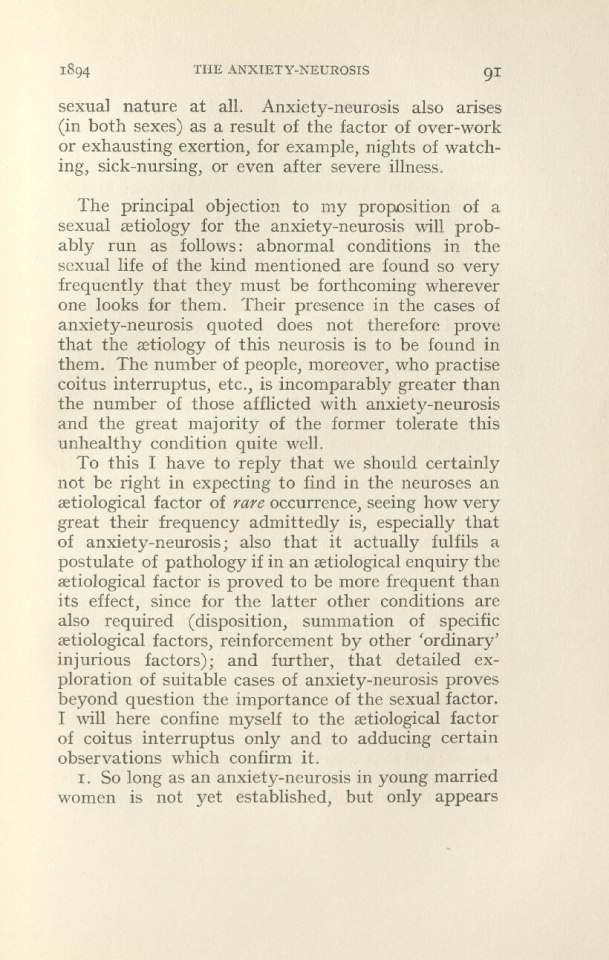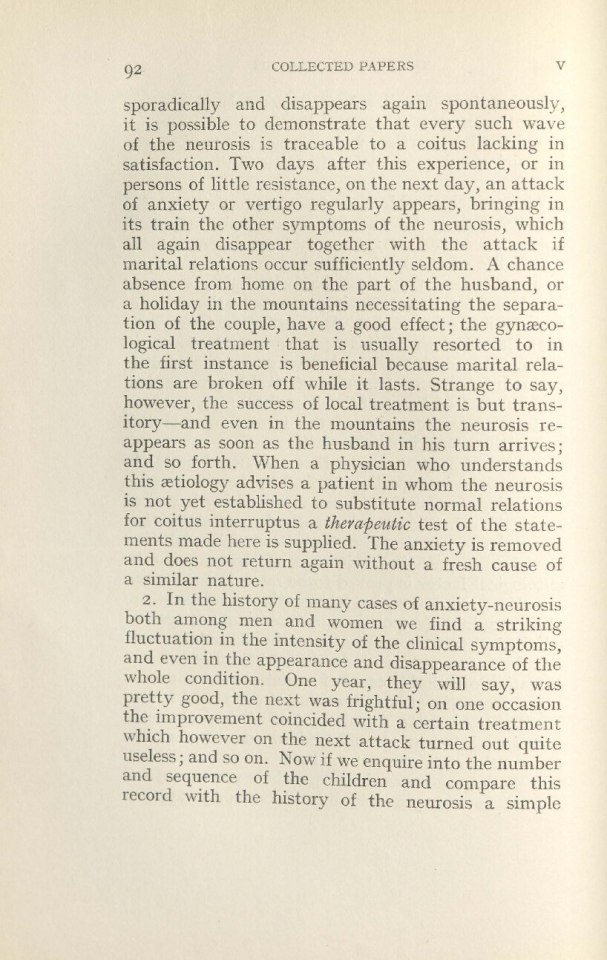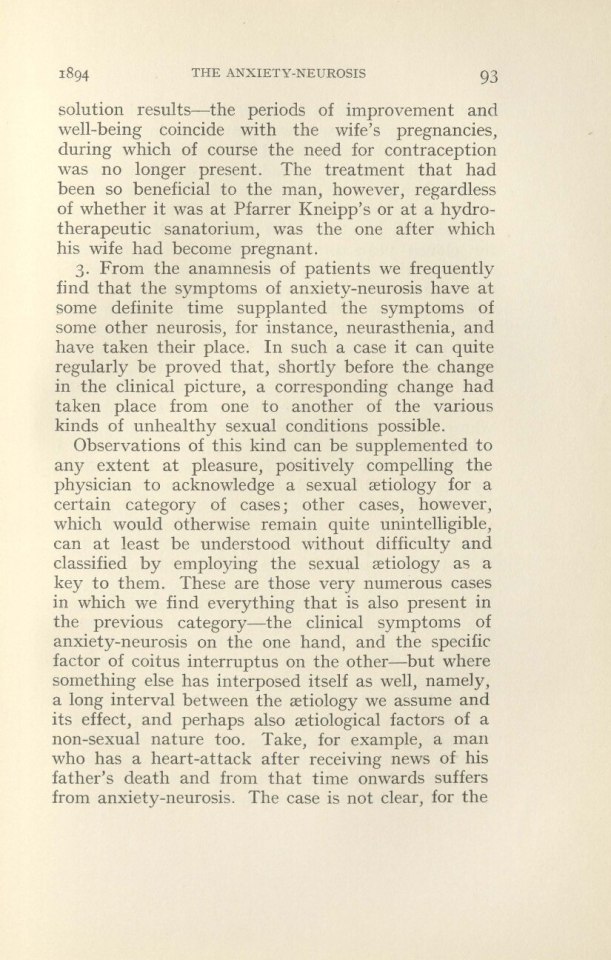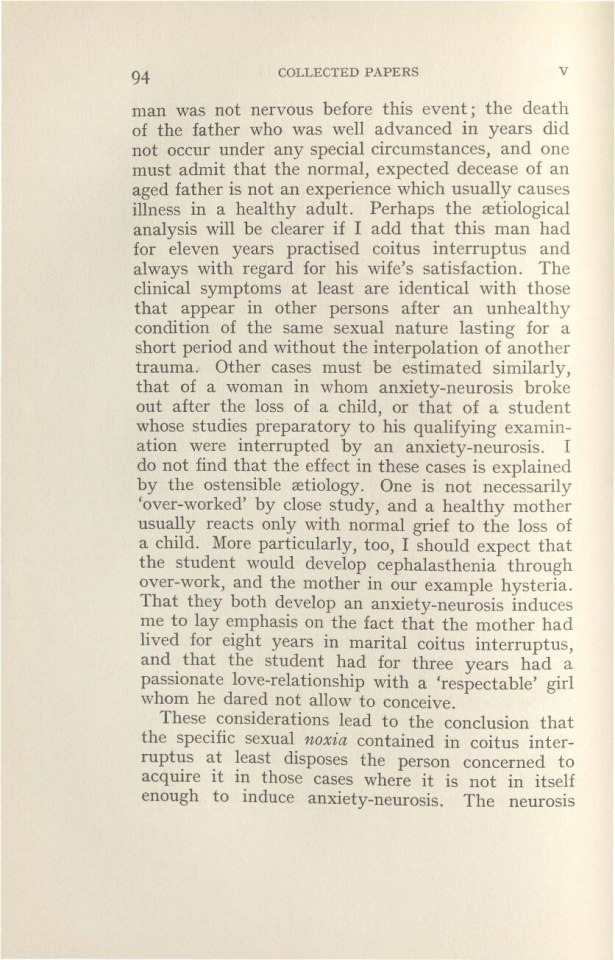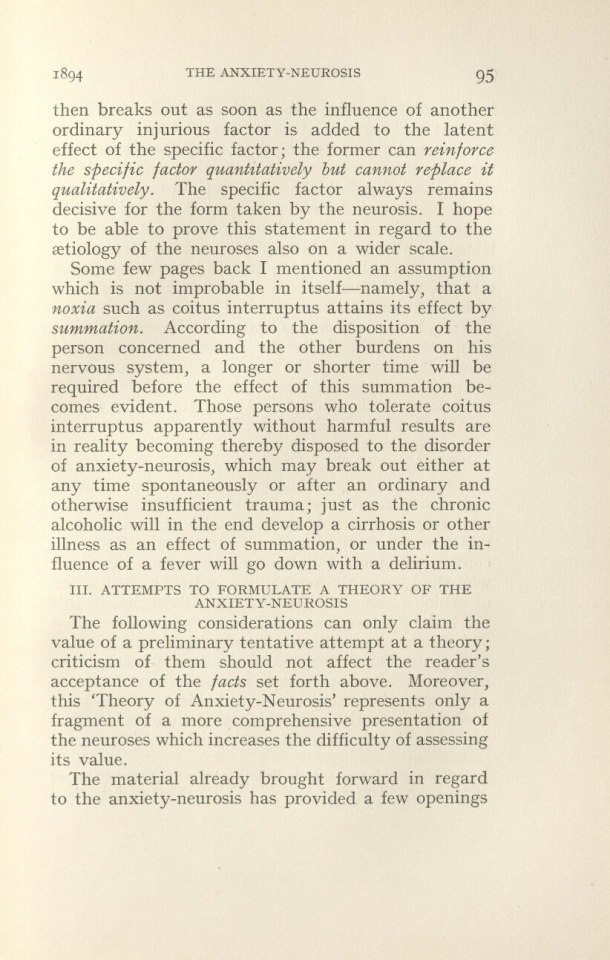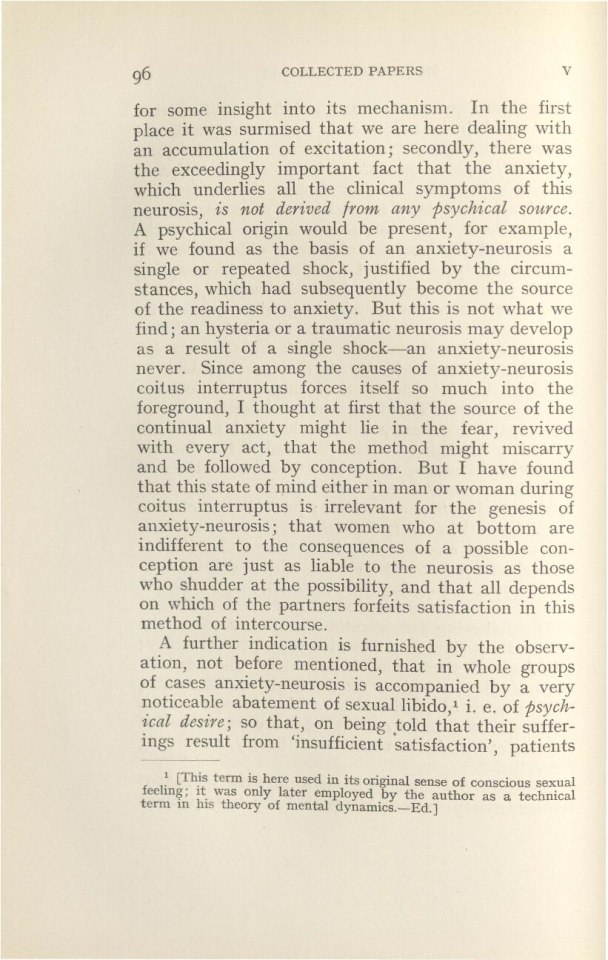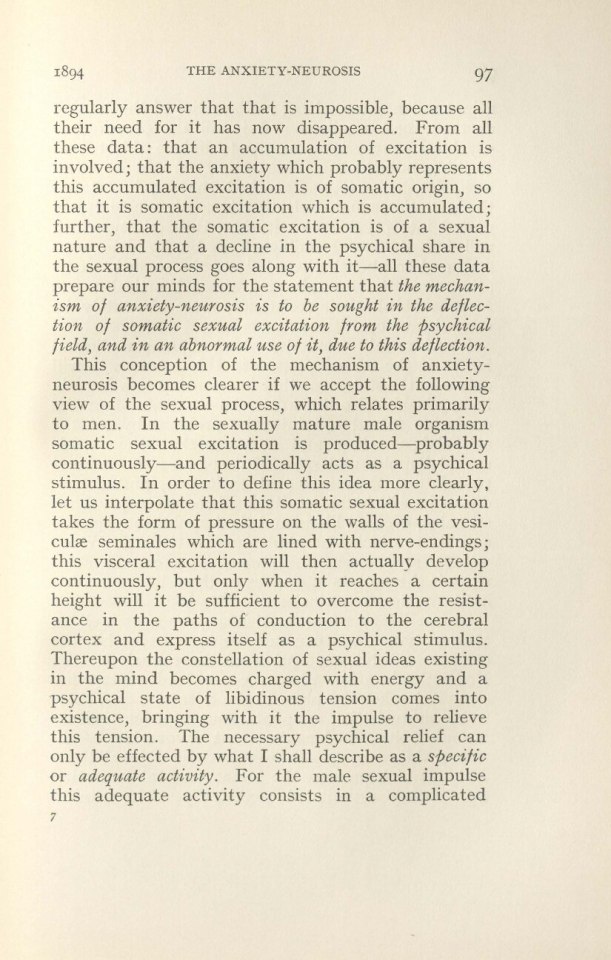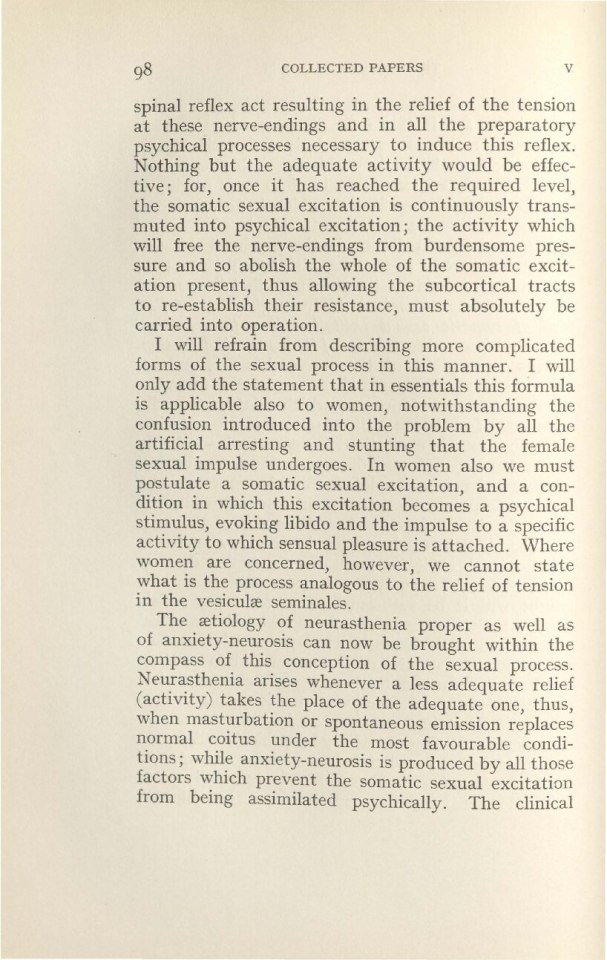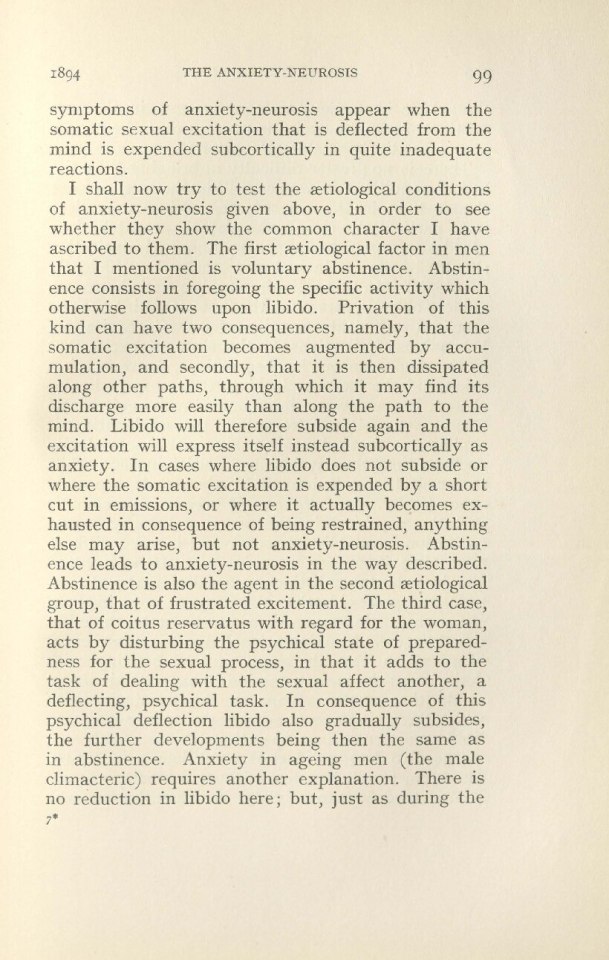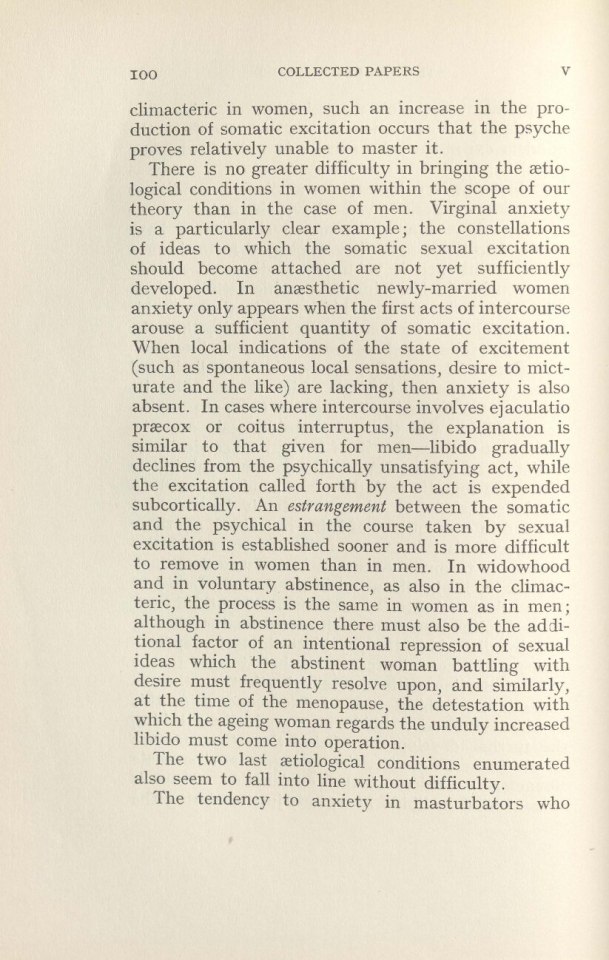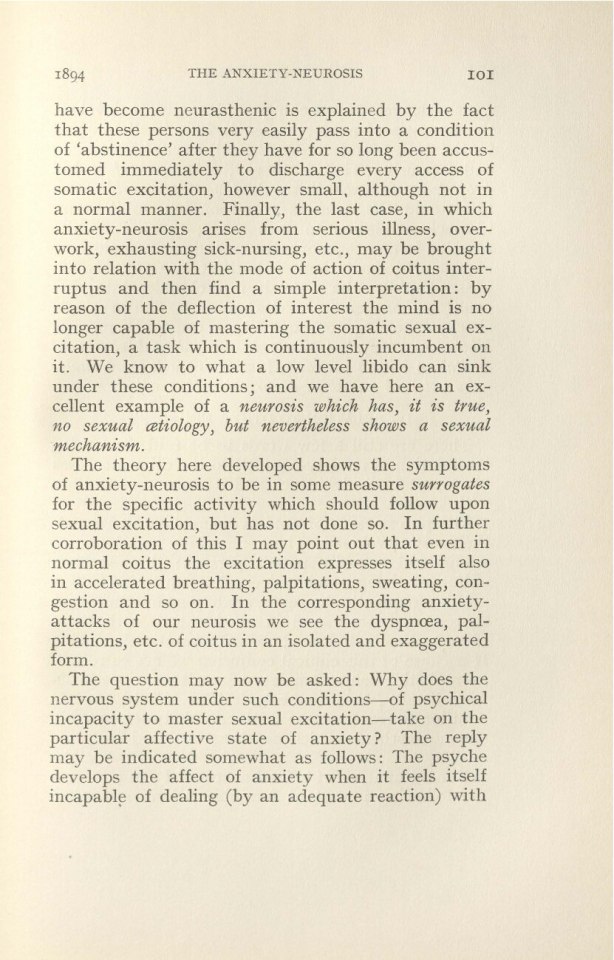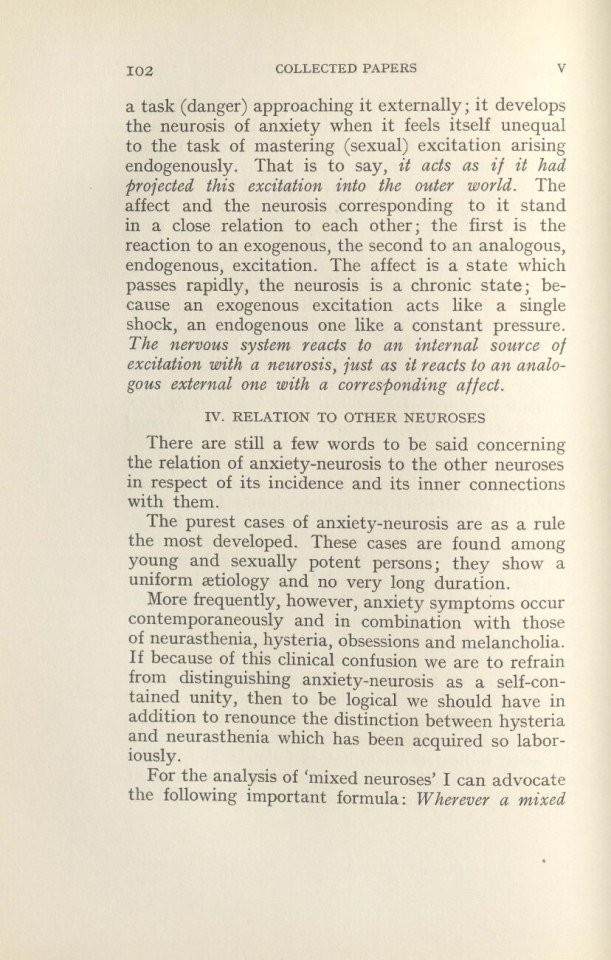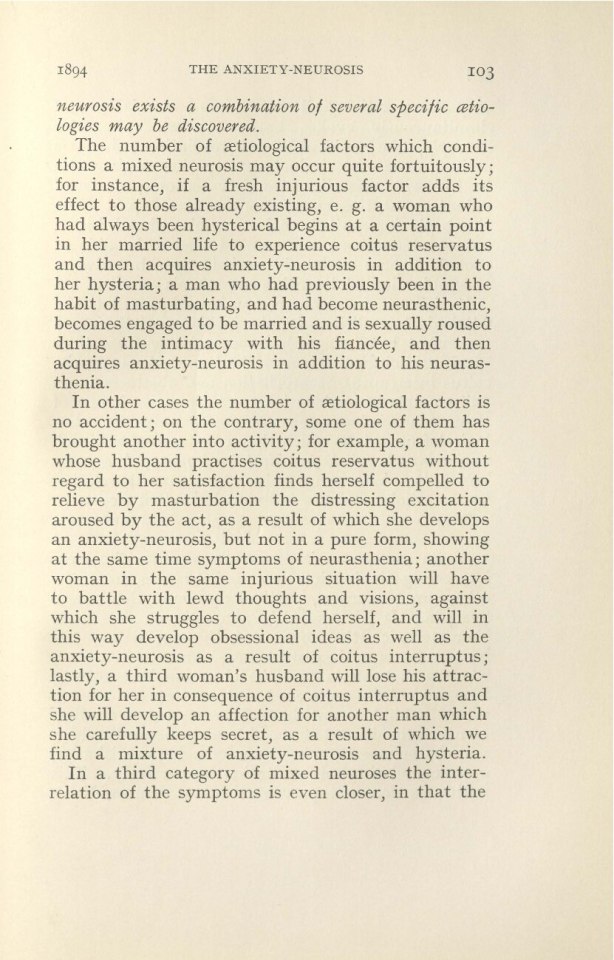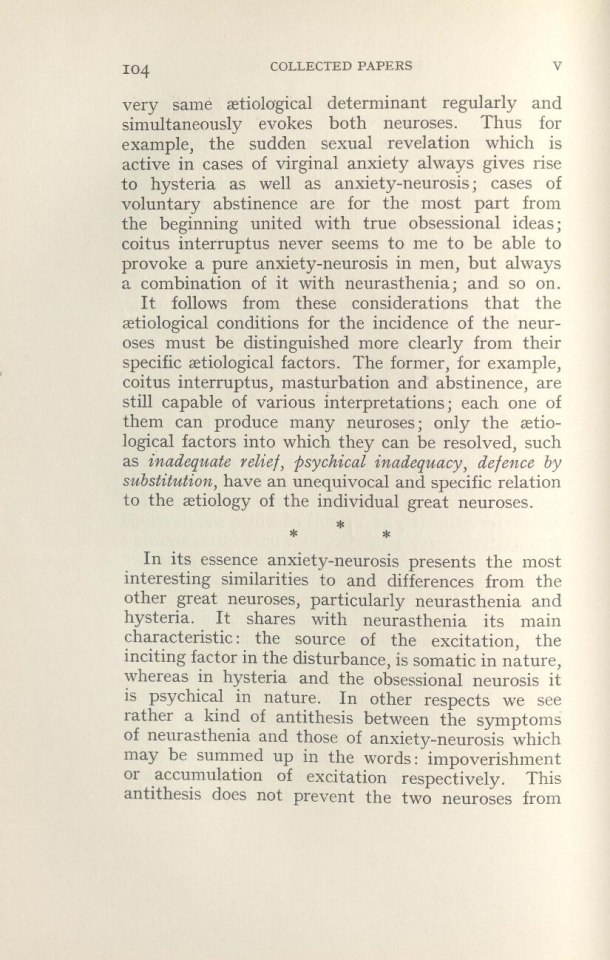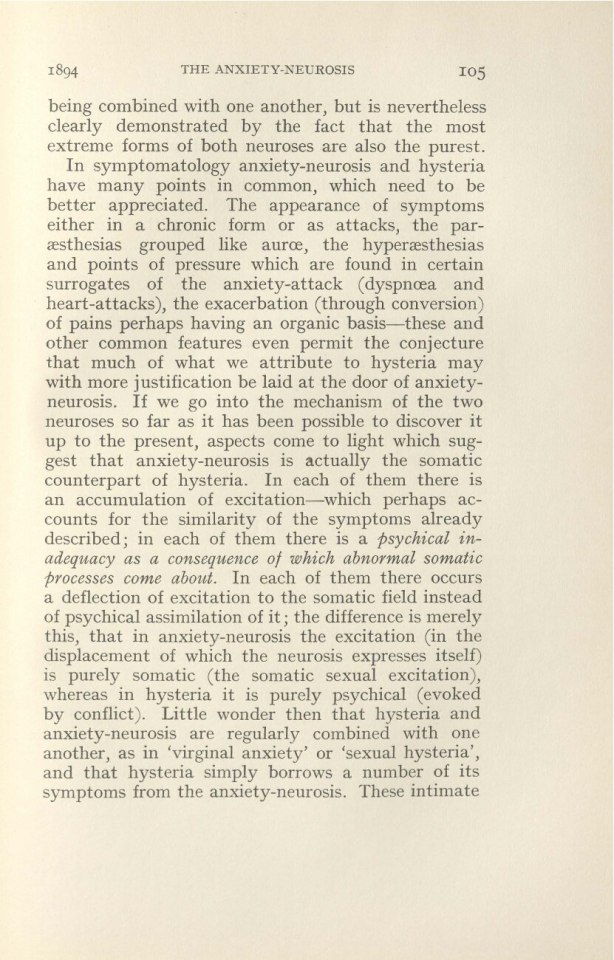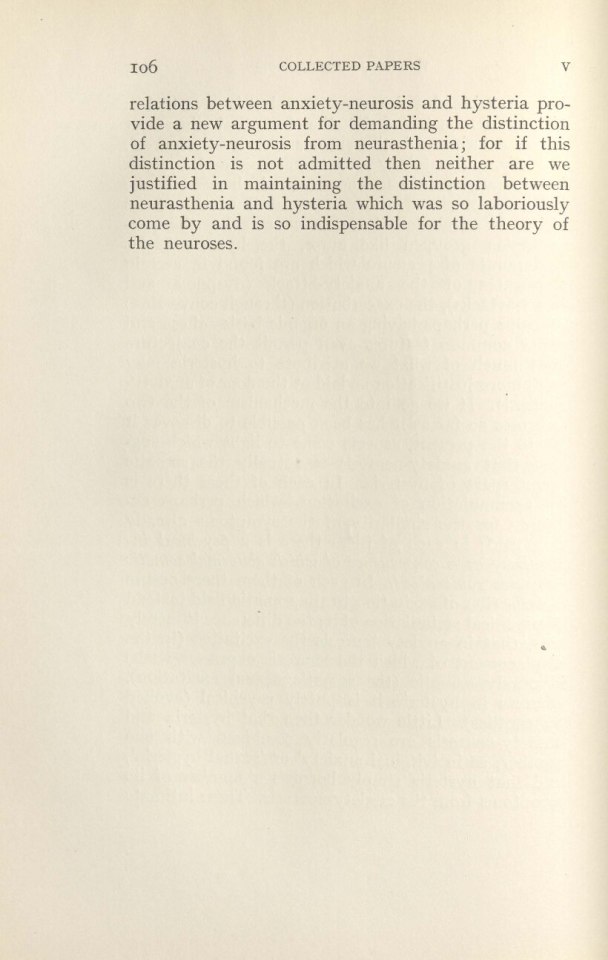S.
V
THE JUSTIFICATION FOR DETACHING
FROM NEURASTHENIA A PARTICULAR
SYNDROME: THE ANXIETY-NEUROSIS!(1894)
t is difficult to say anything of general validity
concerning neurasthenia so long as we allow this
name to cover all that Beard included under the
term. In my opinion, nothing but gain to neuro-
pathology can result if we make an attempt to dis-
tinguish from neurasthenia proper all those neurotic
disturbances of which the symptoms, on the one
hand, are more closely related to one another than
to the typical symptoms of neurasthenia (headache,
spinal irritation, and dyspepsia with flatulence and
constipation) and, on the other hand, show in their
ztiology and their mechanism essential differences
from typical neurasthenia. If we accept this plan
we shall soon obtain a more or less uniform picture
of neurasthenia; and shall then be in a position to
differentiate more sharply than had hitherto been
possible between neurasthenia proper and various
kinds of pseudo-neurasthenia, such as the clinical
picture of the organically determined nasal reflex
neurosis, the nervous disorders of the cachexias and
arterio-sclerosis, the early stages of general paralysis
of the insance and of the psychoses. Further, it will
be possible—as Möbius proposed—to eliminate many
of the nervous conditions of the hereditarily degen-! First published in the Neurologisches Zentralblat Nr. 2
[Translated’ by John Rickman) > Zentralblait, 1805, N. 2S.
1894 THE ANXIETY-NEUROSIS 77
erate; and we shall also find good reason to include
under melancholia many neuroses (especially inter-
mittent and periodic types) which are to-day called
neurasthenia. But the most decisive change of all
will be introduced if we decide to distinguish from
neurasthenia the syndrome I here propose to describe,
which fulfils with unusual completeness the con-
ditions set forth above. The symptoms of this syn-
drome are clinically much more closely related to one
another than to those of neurasthenia proper (that
is, they frequently appear together and replace each
other during the course of the illness), while the
xtiology and mechanism of this neurosis are essen-
tially different from what remains of true neurasthenia
after this subtraction has been made from it.I call this syndrome ‘“Anxiety-Neurosis’, because
all its component elements can be grouped round
the central symptom of ‘morbid anxiety’ and be-
cause individually they each have a definite connec-
tion with this. I believed that this conception of
the symptoms of the anxiety-neurosis had originat-
ed with myself until an interesting paper by
E. Hecker! came into my hands, in which I found
the same idea expounded with the most satisfying
clearness and completeness. Although Hecker re-
cognizes certain symptoms as equivalents or in-
complete manifestations of an anxiety-attack, he
does not separate them from neurasthenia as I
propose to do; this is evidently due to his not having
taken into account the difference in the ztiological
conditions of the two forms of disease. When this
last difference between them is fully recognized, we% E, Hecker; Über larvierte und abortive Angstzustände bei
Neurasthenie. Zentralblatt für Nervenheilkunde, Dec. 1893. Morbid
anxiety is actually quoted as one of the principal symptoms of neur-asthenia in a paper by Kaan: Der neurasthenische Angstaffekt bei
Zwangsvorstellungen und der primordiale Grübelzwang. Wien, 1893.S.
75 COLLECTED PAPERS Yv
have no longer any motive for designating anxiety
symptoms by the same term as those of neurasthenia
proper; for the purpose served by giving a name,
however arbitrary it may be in other respects, is
above all that of enabling us more easily to form
generalizations.I. CLINICAL SYMPTOMATOLOGY OF ANXIETY-NEUROSIS
What I call ‘anxiety-neurosis’ manifests itself in
a partial and in a complete form, and may be met
with either as an isolated state or combined with
other neuroses. The cases which are more or less
complete and at the same time isolated are naturally
those which in particular give support to the idea
that anxiety-neurosis is a clinical entity. In other
cases where there is a complex of symptoms corres-
ponding to a mixed neurosis, we have to distinguish
and separate from it those symptoms which belong
neither to neurasthenia nor to hysteria and so on,
but to anxiety-neurosis.The clinical picture of anxiety-neurosis comprises
the following symptoms:I. General irritability. This is a common nervous
symptom and as such belongs to many nervous
conditions. I include it here because it invariably
appears with anxiety-neurosis and is important
theoretically. An increase of irritability always
signifies an accumulation of excitation or an in-
ability to tolerate such an accumulation, that is, an
absolute or a relative accumulation of excitation.
One form of expression of this increase of irritability
—auditory hyperssthesia—scems to me worthy of
special mention; this undue sensitiveness to noise
is undoubtedly explicable on the basis of the close
inborn connection between auditory impressions and
fright. Auditory hyperzsthesia is frequently a causeS.
1894 THE ANXIETY-NEUROSIS
of sleeplessness, more than one form of which be-
longs to the anxiety-neurosis.2. Anxious expectation. 1 cannot better describe
the condition I have in mind than by this name and
by appending a few examples. A woman who suffers
from anxious expectation will imagine every time
her husband coughs, when he has a cold, that he is
going to have influenzal pneumonia, and will at once
see his funeral in her mind’s eye. If when she is
coming towards the house she sees two people stand-
ing by her front door, she cannot avoid the thought
that one of her children has fallen out of the window,
if the bell rings, then someone is bringing news of
a death, and so on; whereas on all these occasions
there is no particular ground for exaggerating a
mere possibility.Anxious expectation of course fades off imper-
ceptibly into normal anxiousness. It comprises all
that is covered by the word ‘nervousness’—appre-
hensiveness, the tendency to look on the dark side
of things; but at every opportunity it exceeds the
limits of this plausible form of nervousness and is
frequently recognized by the patient himself as a
kind of compulsion. For one form of anxious ex-
pectation—that relating to one’s own health—we
may reserve the old term hypochondria. Hypo-
chondria does not always coincide with a high
degree of anxious expectation; in general it requires
as a preliminary condition the presence of par-
xsthesias and disagreeable bodily sensations, and
therefore hypochondria is the form favoured by
true neurasthenics when they fall victims to anxiety-
neurosis, as they often do.The tendency to pangs of conscience, scrupulous-
ness and pedantry may be a further expression of
anxious expectation, a tendency which is especiallyS.
80 COLLECTED PAPERS Yv
frequent among morally sensitive people and like-
wise ranges {rom the normal to an exaggeration
known as folie dw doute.Anxious expectation is the nuclear symptom of
this neurosis; it clearly reveals, too, something of
the theory of it. We may perhaps say that there is
here a guantum of amxieiy in a free-floating con-
dition, which in any state of expectation controls
the selection of ideas, and is ever ready to attach
itself to any suitable ideational content.3. This is not the only way in which apprehensive-
ness—which is not usually present in consciousness
but is ever lying in wait—can express itsclf. It can, on
the contrary, erupt suddenly into consciousness with-
out being called forth by any train of thought, and
thus bring about an anxiety-attack. An anxiety-attack
of this kind either consists of a feeling of anxiety alone
without any associated idea, or associated with the
nearest interpretation, such as sudden death, a stroke,
or approaching insanity; or else the feeling of
anxiety is combined with parssthesias (similar to
the hysterical aura); or finally, together with the
feeling of anxiety there is an accompanying disturb-
ance of any one or more of the bodily functions, such
as respiration, heart’s action, vasomotor innervation,
or glandular activity. The patient lays stress on one
or other of these symptoms, and complains of
“heart-spasms’, ‘difficulty in breathing’, ‘drenching
sweats’, ‘'ravenous hunger’ and the like; and in his
description the feeling of anxiety frequently recedes
into the background or is described quite vaguely
as a feeling of illness’, of ‘distress’, and so on.4. It is interesting, and important diagnostically,
that the degree to which these elements are combined
in anxiety-attacks varies extraordinarily, and that
almost every accompanying symptom can aloneS.
1894 THE ANXIETY-NEUROSIS 81
constitute the attack just as well as the anxiety
itself can. There are consequently rudimentary
anxiety-attacks and equivalents of an anxiety-attack (all
probably having the same meaning), showing a
manifold and hitherto little appreciated variety of
forms. A closer study of these larval anxiety-states
(Hecker) and their diagnostic differentiation from
other attacks should soon become a necessary piece
of work in neuropathology.I will here append a list including only those types
of anxiety-attack known to me:a. Attacks accompanied by disturbances of the
heart's action, such as palpitation, either with trans-
itory arhythmia, or with tachycardia of longer
duration that may end in grave weakness of the
heart, the differentiation from organic morbus cordis
never being easy; or pseudo-angina pectoris—dia-
gnostically a delicate problem!b. Attacks accompanied by disturbances of res-
piration, several forms of nervous dyspnoea, attacks
similar to asthma, and the like. I would emphasize
that even these attacks are not always accompanied
by recognizable anxiety.ce. Attacks of sweating, often nocturnal.
d. Attacks of tremor and shuddering, which are
only too easily confounded with hysteria.e. Attacks of ravenous hunger, often accompanied
by giddiness.f. Attacks of sudden diarrhea.
g. Attacks of locomotor vertigo.
h. Attacks of so-called congestion, practically em-
bracing all that has been called vasomotor neur-
asthenia.i. Attacks of paresthesias (but these seldom occur
without anxiety or some similar feeling of distress).
6S.
82 COLLECTED PAPERS Yv
5. Awakening in fright (the bavor nocturnus of
adults), which is usually combined with morbid
anxiety, dyspnoa, sweating and the like, is very
frequently nothing but a variety of the anxiety
attack. This disturbance conditions a second type
of sleeplessness which also lies within the compass
of anxiety-neurosis—I have no doubt in my own
mind that the Davor nocturnus of children also in-
cludes a type which belongs to anxiety-neurosis.
The hysterical tinge, i. e. the coupling of morbid
anxiety with the reproduction of some appropriate
experience of dream, gives the davor nocturnus of
children the appearance of being something distinct;
but it also appears in a pure form without dream or
recurring hallucination.6. Vertigo takes a prominent place in the group
of symptoms of the anxiety-neurosis. Its mildest
form is better described as giddiness; and its graver
manifestations, ‘attacks of vertigo’ (with or without
anxiety), constitute one of the most momentous
symptoms of this disease. The dizziness of the
anxiety-neurosis is neither rotatory nor is it confined
to particular planes or directions as is Meniere’s
vertigo. It belongs to the class of locomotor or co-
ordinatory dizziness, as do the cases of oculo-motor
paralysis; it consists of a specific discomfort accom-
panied by the feeling that the ground is rocking, the
legs giving way, that one can’t keep upright be-
cause one’s legs are as heavy as lead and are shaking
and wobbling. This dizziness never leads to a fall.
I venture, however, to assert that a profound fainting
fit may supervene in the place of an attack of vertigo
of this kind. Other swoon-like conditions in anxiety-
neurosis appear to result from cardiac collapse.An attack of vertigo is not seldom accompanied
by the worst kind of morbid anxiety, and is fre-S.
1894 THE ANXIETY-NEUROSIS 83
quentiy attended by cardiac and respiratory disturb-
ances. According to my observations the vertigo
produced by heights, mountains and precipices also
frequently belongs to the anxiety-neurosis; further,
I do not know whether one would not be justified
in recognizing alongside this the existence of a vertigo
of gastric origin.7. On the basis of chronic apprehensiveness (anxious
expectation) on the one hand, and a tendency
to attacks of vertigo with anxiety on the other, two
groups of typical phobias develop, the first relating
to common physiological dangers, the other to loco-
motion. To the first group belongs the fear of snakes,
thunderstorms, darkness, vermin, and so on, as well
as the typical moral over-sensitiveness, and the
forms of ‘“folie du doute’ ; the available anxiety is here
used simply to exaggerate the aversions which are
implanted instinctively in everyone. Usually, how-
ever, a phobia with obsessive strength arises only
when, added to such an instinctive aversion, a
reminiscence of an experience in which the anxiety
could come to expression supervenes—for example,
after the patient has actually experienced a thunder-
storm in the open air. To attempt to explain such
cases as mere continuations of strong impressions
would be incorrect; what makes these experiences
significant and their retention in memory of long
duration is indeed simply the anxiety, which both
originally and subsequently thus found a means of
expression. In other words, such impressions remain
potent only in cases where ‘anxious expectation’
is present.The other group includes agoraphobia with all its
accessory forms, collectively characterized by their
relation to movement. We frequently find a pre-
cursory attack of vertigo as the foundation of the
uS.
84 COLLECTED PAPERS NV
phobia; but I do not believe that one can postulate
this every time. Occasionally we see that after a
first attack of giddiness without anxiety locomotion
still continues possible without hindrance, although
henceforth constantly accompanied by the sensation
of giddiness; but that under certain conditions, such
as being alone, in narrow streets and so on, loco-
motion becomes impossible when once anxiety has
become combined with an attack of vertigo.The relation of these phobias to those of the
obsessional neurosis, the mechanisms of which I
have discussed in an earlier paper! in this Journal,
is of the following kind: the correspondence between
them is that in both an idea becomes obsessive in
consequence of its being connected with an un-
attached affect. The mechanism of transposition of
affect holds good therefore for both kinds of phobia;
but in the phobias of the anxiety-neurosis (1) this
affect is always the same, always that of anxiety;
(2) it does not originate in a repressed idea, proves
not reducible further by psychological analysis, and
is also not amenable to psychotherapy. The mechan-
ism of substitution does not therefore hold good for
the phobias of the anxiety-neurosis.Both kinds of phobias (or obsessional idcas) fre-
quently appear side by side, although the atypical
phobias which are based on obsessional ideas nced
not necessarily develop on the basis of an anxiety-
neurosis. A very frequent, apparently complicated
mechanism makes its appearance when the content
of an originally simple phobia of the anxiety-neurosis
type is replaced by another idea, the substitution
being then subsequently added to the phobia. The
protective measures’ originally directed towards
combating the phobia are the ideas most frequently1 See No. IV of this volume, above, p. 50.
S.
1894 THE ANXIETY-NEUROSIS 85
employed as substitutions. Thus, for example, ‘brood-
ing mania’ arises from the patient’s effort to dis-
prove that he is crazy, as his hypochondriacal phobia
maintains: the hesitations and doubts, and still more
the repetitions, of folie du doute, arise from a justi-
fiable doubt about his own powers of correct reason-
ing, since he is aware of the persistent disturbance
of the obsessional idea; and so on. We can there-
fore assert that many syndromes of the obsessional
neurosis, such as folie ds doute and the like, are also
clinically, though not conceptually, to be reckoned
as belonging to the anxiety-neurosis.!8. Digestive processes are subject to only a few
disturbances in anxiety-neurosis, but these are char-
acteristic. Sensations such as nausea and biliousness
are not at all rare, and the symptom of ravenous
hunger can, by itself or in combination with others
(congestions), constitute a rudimentary anxiety-
attack; as a chronic condition analogous to anxious
expectation we find a tendency to diarrhoa which
has given rise to the queerest diagnostic mistakes.
If I am not mistaken, it is this diarrh@a to which
Möbius® has recently called attention in a short
paper. I conjecture further that Peyer’s reflex
diarrhoea, which he derives from the disorders of
the prostate,® is nothing but this diarrhaa of anx-
iety-neurosis. The deception of a-reflex relationship
comes about because the same factors which are
active in the origin of such prostatic affections also
come into play in the zetiology of anxiety-neurosis.The behaviour of the gastro-intestinal tract in
anxiety-neurosis presents a sharp contrast to tlıe
influence of neurasthenia on those functions. Mixed’ Sec No. VII of this volume, p. 128.
= Möbius: Neuropathologische Beiträge, Heft 2, 1894.
® Peyer: Die nervösen Affektionen des Darmes. Wiener Klinik,
January, 1893.S.
86 COLLECTED PAPERS v
cases often show the well-known ‘alternation of
diarrhea and constipation’. The urgent need to
micturate that occurs in the anxiety-neurosis is
analogous to this diarrhoea.9. The parasthesias which may accompany attacks
of vertigo or anxiety are interesting in that they
(as also the sensations of the hysterical aura) be-
come associated in a definite sequence; but I find
that, in contrast to those of hysteria, these asso-
ciated sensations are atypical and changing. A further
similarity to hysteria ensues because a kind of
conversion‘, which may otherwise easily be over-
looked, to bodily sensations takes place in anxiety-
neurosis, e. g. a conversion which takes effect in
rheumatic muscles. Quite a number of rheumatic
persons, so-called, who moreover are demonstrable as
such, in reality suffer from anxiety-neurosis. Along
with this increased sensitiveness to pain I have obser-
ved in a series of cases of anxiety-neurosis a tendency
to hallucinations which could not be explained as
hysterical.Io. Several of the symptoms mentioned which
accompany or take the place of an anxiety-attack
appear also in a chronic form. They are then still
less easy to recognize, since the accompanying
anxious sensation is less clearly recognizable than in
anxiety-attacks. This is particularly true of diar-
rhoea, vertigo, parzsthesias. Just as an attack of
vertigo may be replaced by a fainting-fit, so may
chronic giddiness be replaced by a constant feeling
of sinking to the ground, exhaustion, etc.1. THEINCIDENCE AND ETIOLOGYOFANXIETY-NEUROSIS
In many cases of anxiety-neurosis no ztiology is
recognizable at all. It is remarkable that in such* See No. IV of this volume, above, p. 50.
S.
1894 THE ANXIETY-NEUROSIS 87
cases evidence of a grave hereditary taint is seldom
diffieult to establish.But where there are grounds for regarding the
neurosis as an acquired one, careful enquiry to that
end reveals a series of injurious conditions (noxie)
and influences within the sexual life as important
factors in the ztiology. At first sight these appear
to be very various in their nature but they soon
disclose their common character, which explains the
fact that they always have the same effect on the
nervous system; further, they are either present
alone or together with other ‘ordinary’ injurious
factors, which latter may be regarded as having a
contributory effect. As this sexual ztiology of the
anxiety-neurosis is so very commonly demonstrable
I feel justified for the purpose of this short paper in
disregarding cases with a doubtful or a different
ztiology.In setting forth in greater detail the ztiological
conditions under which anxiety-neurosis makes its
appearance it will be advisable to treat of men and
women separately. Anxiety-neurosis appears in
female persons—disregarding for the moment their
predisposition—in the following cases:a. as virginal anxiety or anxiety in adolescents.
A number of unambiguous observations has shown
me that anxiety-neurosis can be evoked in maturing
girls by their first meeting with the sexual problem,
that is, by any more or less sudden revelation of
what had hitherto been hidden, for example, seeing
the sexual act, or hearing or reading something of
that nature; in these cases anxiety-neurosis is typic-
ally combined with hysteria;b. as anxiety in the newly-married. Young married
women who remain ansthetic during the first acts
of intercourse often fall ill of an anxiety-neurosisS.
COLLECTED PAPERS Vv
which again disappears as soon as the anzsthesia
gives way to normal sensitivity. Since the majority
of young women remain healthy during a temporary
anzsthesia of this kind, there are conditions neces-
sary to the outbreak of this anxiety, which I will
mention later;c. as anxiety in women whose husbands suffer
from ejaculatio pracox or from impaired potency ; andd. whose husbands practise coitus interruptus or
reservatus. These cases belong together, for on
analysing a large number of examples it is easy to
convince oneself that they depend simply on whether
the wife obtains satisfaction in coitus or not. The
latter case provides the condition for the genesis of
an anxiety-neurosis. On the other hand, the wife is
saved from neurosis if the husband who is afflicted
with ejaculatio pracox can immediately repeat the
congress with a better result. Congressus reservatus
by means of condoms is not injurious to the wife if
she is very quickly roused and the husband very
potent; if not, this kind of contraception is no less
injurious than the others. Coitus interruptus is almost
always harmful; though only for the wife when the
husband practises it regardlessiy, that is to say,
when he interrupts coitus as soon as he is near to
ejaculation without troubling himself about the stage
of his wife’s excitement. If on the other hand the
husband waits for his wife’s satisfaction then the
coitus will be equivalent to the normal for her—but
the husband will become a sufferer from anxiety-
neurosis. I have collected and analysed a great
number of observations which have provided the
material for these conclusions;e. as anxiely in widows and voluntarıly abstinent
bersons, often found in typical combination with
obsessional ideas;S.
1894 THE ANXIETY-NEUROSIS 89
f. as anxiety in the climacterie during the last
great increase of sexual need.Cases c., d., and e. embrace the conditions un-
der which anxiety-neurosis in the female sex most fre-
quently arises and is least dependent on hereditary
predisposition. On the basis of these cases of anxiety-
neurosis—curable, acquired cases—I shall try to
prove that the injurious sexual condition (noxia)
discovered in them really represents the »tiological
factor of this neurosis. Before doing so, however,
I will go on to discuss the sexual conditions for
anxiety-neurosis in men. I propose to set up the
following groups, which all have their analogies
among women:a. anxiety of the voluntarily abstinent, frequently
combined with defence symptoms (obsessional ideas,
hysteria). The motives which are decisive for inten-
tional abstinence bring it about that a number of
hereditarily-disposed or eccentrie persons, etc. belong
to this category;b. anxiety in men during frustrated excitement
(during an engagement to marry), in persons who
(from fear of the consequences of sexual intercourse)
content themselves with handling or gazing at the
woman. This group of conditions (which by the
way applies equally to the other sex: engagement,
relationships involving sexual forbearance) furnishes
the purest cases of the neurosis;c. anxiety in men who practise coitus interruptus.
As has been said already, coitus interruptus is
harmful to the woman when it is practised without
regard to her satisfaction; but it becomes harmful to
the man if, in order to provide satisfaction for the
woman, he voluntarily controls coitus and delays
the ejaculation. It thus becomes intelligible that as
a rule only one partner of a married couple practis-S.
90 COLLECTED PAPERS v
ing coitus interruptus falls ill. Incidentally, coitus
interruptus but rarely leads to a pure anxiety-neur-
osis in men; there usually results a combination of
it with neurasthenia;d. anxiety in ageing men. There are men who
have a climacteric like women and who develop
anxiety- neurosis at the time of their waning potency
and increased libido.Finally I must add two other cases which are
valid for both sexes:e. The neurasthenics who after practising masturb-
ation fall victims to anxiety-neurosis as soon as
they desist from their form of sexual gratification.
These persons have rendered themselves particularly
incapable of tolerating abstinence.I observe here that in order to understand the
anxiety-neurosis it is important to realize that any
pronounced manifestation of it occurs only among
men who are still potent and among women who
are not anzssthetic. Among neurasthenics whose
potency has already been seriously diminished by
masturbation, the anxiety-neurosis resulting from
abstinence is of a very meagre character and con-
fines itself as a rule to hypochondria and mild chronic
dizziness. The majority of women are to be regarded
as ‘potent’; a really impotent, i. e. really anzsthetic,
woman is likewise only mildly affected by anxicty-
neurosis and tolerates the injurious sexual conditions
described surprisingly well.How far beyond this we may be justified in post-
ulating a constant relation between particular &tio-
logical factors and particular symptoms in the
complex of anxiety-neurosis, I do not yet wish to
express any opinion.7. The last of the ztiological conditions I have to
bring forward appears at first sieht not to be of aS.
1894 THE ANXIETY-NEUROSIS gI
sexual nature at all. Anxiety-neurosis also arises
(in both sexes) as a result of the factor of over-work
or exhausting exertion, for example, nights of watch-
ing, sick-nursing, or even after severe illness.The principal objection to my proposition of a
sexual ztiology for the anxiety-neurosis will prob-
ably run as follows: abnormal conditions in the
scxual life of the kind mentioned are found so very
frequently that they must be forthcoming wherever
one looks for them. Their presence in the cases of
anxiety-neurosis quoted does not therefore prove
that the tiology of this neurosis is to be found in
them. The number of people, moreover, who practise
coitus interruptus, etc., is incomparably greater than
the number of those afflicted with anxiety-neurosis
and the great majority of the former tolerate this
unhealthy condition quite well.To this I have to reply that we should certainly
not be right in expecting to find in the neuroses an
setiological factor of rare occurrence, seeing how very
great their frequency admittedly is, especially that
of anxiety-neurosis; also that it actually fulfils a
postulate of pathology ifin an ztiological enquiry the
zetiological factor is proved to be more frequent than
its effect, since for the latter other conditions are
also required (disposition, summation of specific
xtiological factors, reinforcement by other ‘ordinary’
injurious factors); and further, that detailed ex-
ploration of suitable cases of anxiety-neurosis proves
beyond question the importance of the sexual factor.
I will here confine myself to the ztiological factor
of coitus interruptus only and to adducing certain
observations which confirm it.1. So long as an anxiety-neurosis in young married
women is not yet established, but only appearsS.
92 COLLECTED PAPERS V
sporadically and disappears again spontaneously,
it is possible to demonstrate that every such wave
of the neurosis is traceable to a coitus lacking in
satisfaction. Two days after this experience, or in
persons of little resistance, on the next day, an attack
of anxiety or vertigo regularly appears, bringing in
its train the other symptoms of the neurosis, which
all again disappear together with the attack if
marital relations occur sufficiently seldom. A chance
absence from home on the part of the husband, or
a holiday in the mountains necessitating the separa-
tion of the couple, have a good effect; the gynaco-
logical treatment that is usually resorted to in
the first instance is beneficial because marital rela-
tions are broken off while it lasts. Strange to say,
however, the success of local treatment is but trans-
itory—and even in the mountains the neurosis re-
appears as soon as the husband in his turn arrives;
and so forth. When a physician who understands
this »tiology advises a patient in whom the neurosis
is not yet established to substitute normal relations
for coitus interruptus a therapeutic test of the state-
ments made here is supplied. The anxiety is removed
and does not return again without a fresh cause of
a similar nature.2. In the history of many cases of anxiety-ncurosis
both among men and women we find a striking
fluctuation in the intensity of the clinical symptoms,
and even in the appearance and disappearance of tlıe
whole condition. One year, they will say, was
pretty good, the next was frightful; on one occasion
the improvement coincided with a certain treatment
which however on the next attack turned out quite
useless; and so on. Now if we enquire into the number
and sequence of the children and compare this
record with the history of the neurosis a simpleS.
1894 THE ANXIETY-NEUROSIS 93
solution results—-the periods of improvement and
well-being coincide with the wife’s Pregnancies,
during which of course the need for contraception
was no longer present. The treatment that had
been so beneficial to the man, however, regardless
of whether it was at Pfarrer Kneipp’s or at a hydro-
therapeutic sanatorium, was the one after which
his wife had become pregnant.3- From the anamnesis of patients we frequently
find that the symptoms of anxiety-neurosis have at
some definite time supplanted the symptoms of
some other neurosis, for instance, neurasthenia, and
have taken their place. In such a case it can quite
regularly be proved that, shortly before the change
in the clinical picture, a corresponding change had
taken place from one to another of the various
kinds of unhealthy sexual conditions possible.Observations of this kind can be supplemented to
any extent at pleasure, positively compelling the
Physician to acknowledge a sexual ztiology for a
certain category of cases; other cases, however,
which would otherwise remain quite unintelligible,
can at least be understood without difficulty and
classified by employing the sexual xtiology as a
key to them. These are those very numerous cases
in which we find everything that is also present in
the previous category—the clinical symptoms of
anxiety-neurosis on the one hand, and the specific
factor of coitus interruptus on the other—but where
something else has interposed itself as well, namely,
a long interval between the xtiology we assume and
its effect, and perhaps also xtiological factors of a
non-sexual nature too. Take, for example, a man
who has a heart-attack after receiving news of his
father’s death and from that time onwards suffers
from anxiety-neurosis. The case is not clear, for theS.
94 COLLECTED PAPERS Yv
man was not nervous before this event; the death
of the father who was well advanced in years did
not occur under any special circumstances, and onc
must admit that the normal, expected decease of an
aged father is not an experience which usually causes
illness in a healthy adult. Perhaps the z»tiological
analysis will be clearer if I add that this man had
for eleven years practised coitus interruptus and
always with regard for his wife’s satisfaction. The
clinical symptoms at least are identical with those
that appear in other persons after an unhealthy
condition of the same sexual nature lasting for a
short period and without the interpolation of another
trauma. Other cases must be estimated similarly,
that of a woman in whom anxiety-neurosis broke
out after the loss of a child, or that of a student
whose studies preparatory to his qualifying examin-
ation were interrupted by an anxiety-neurosis. I
do not find that the effect in these cases is explained
by the ostensible ztiology. One is not necessarily
‘over-worked’ by close study, and a healthy mother
usually reacts only with normal grief to the loss of
a child. More particularly, too, I should expect that
the student would develop cephalasthenia through
over-work, and the mother in our example hysteria.
That they both develop an anxiety-neurosis induces
me to lay emphasis on the fact that the mother had
lived for eight years in marital coitus interruptus,
and that the student had for three years had a
passionate love-relationship with a ‘respectable’ girl
whom he dared not allow to conceive.These considerations lead to the conclusion that
the specific sexual noxia contained in coitus inter-
ruptus at least disposes the person concerned to
acquire it in those cases where it is not in itself
enough to induce anxiety-neurosis. The neurosisS.
1894 THE ANXIETY-NEUROSIS 95
then breaks out as soon as the influence of another
ordinary injurious factor is added to the latent
effect of the specific factor; the former can reinforce
the specific factor quantıtatively but cannot replace it
qualitatively. The specific factor always remains
decisive for the form taken by the neurosis. I hope
to be able to prove this statement in regard to the
tiology of the neuroses also on a wider scale.Some few pages back I mentioned an assumption
which is not improbable in itself—namely, that a
noxıa such as coitus interruptus attains its effect by
summation. According to the disposition of the
person concerned and the other burdens on his
nervous system, a longer or shorter time will be
required before the effect of this summation be-
comes evident. Those persons who tolerate coitus
interruptus apparently without harmful results are
in reality becoming thereby disposed to the disorder
of anxiety-neurosis, which may break out either at
any time spontaneously or after an ordinary and
otherwise insufficient trauma; just as the chronic
alcoholic will in the end develop a cirrhosis or other
illness as an effect of summation, or under the in-
fluence of a fever will go down with a delirium.III. ATTEMPTS TO FORMULATE A THEORY OF THE
ANXIETY-NEUROSIS
The following considerations can only claim the
value of a preliminary tentative attempt at a theory;
critieism of them should not affect the reader’s
acceptance of the facts set forth above. Moreover,
this ‘Theory of Anxiety-Neurosis’ represents only a
fragment of a more comprehensive presentation of
the neuroses which increases the difficulty of assessing
its value.The material already brought forward in regard
to the anxiety-neurosis has provided a few openingsS.
96 COLLECTED PAPERS
for some insight into its mechanism. In the first
place it was surmised that we are here dealing with
an accumulation of excitation; secondly, there was
the exceedingly important fact that the anxiety,
which underlies all the clinical symptoms of this
neurosis, is not derived from any psychical source.
A psychical origin would be present, for example,
if we found as the basis of an anxiety-neurosis a
single or repeated shock, justified by the circum-
stances, which had subsequently become the source
of the readiness to anxiety. But this is not what we
find; an hysteria or a traumatic neurosis may develop
as a result of a single shock—an anxiety-neurosis
never. Since among the causes of anxiety-neurosis
coitus interruptus forces itself so much into the
foreground, I thought at first that the source of the
continual anxiety might lie in the iear, revived
with every act, that the method might miscarry
and be followed by conception. But I have found
that this state of mind either in man or woman during
coitus interruptus is irrelevant for the genesis of
anxiety-neurosis; that women who at bottom are
indifferent to the consequences of a possible con-
ception are just as liable to the neurosis as those
who shudder at the possibility, and that all depends
on which of the partners forfeits satisfaction in this
method of intercourse.A further indication is furnished by the observ-
ation, not before mentioned, that in whole groups
of cases anxiety-neurosis is accompanied by a very
noticeable abatement of sexual libido,t i. e. of dsych-
ical desire; so that, on being told that their suffer-
ings result from nsufficient satisfaction’, patientsı [This term is here used in its original sense of conscious sexual
feeling; it was only later employed th i
der I hi hear of mental Oybamie a son 58 a technicalS.
1894 THE ANXIETY-NEUROSIS 97
regularly answer that that is impossible, because all
their need for it has now disappeared. From all
these data: that an accumulation of excitation is
involved; that the anxiety which probably represents
this accumulated excitation is of somatic origin, so
that it is somatic excitation which is accumulated;
further, that the somatic excitation is of a sexual
nature and that a decline in the psychical share in
the sexual process goes along with it—all these data
prepare our minds for the statement that the mechan-
ism of anxiety-neurosis is to be sought in the deflec-
tion of somatic sexual excitation from the Ppsychical
field, and in an abnormal use of it, due to this deflection.This conception of the mechanism of anxiety-
neurosis becomes clearer if we accept the following
view of the sexual process, which relates primarily
to men. In the sexually mature male organism
somatic sexual excitation is produced—probably
continuously—and periodically acts as a psychical
stimulus. In order to define this idea more clearly,
let us interpolate that this somatic sexual excitation
takes the form of pressure on the walls of the vesi-
cule seminales which are lined with nerve-endings;
this visceral exeitation will then actually develop
continuously, but only when it reaches a certain
height will it be sufficient to overcome the resist-
ance in the paths of conduction to the cerebral
cortex and express itself as a psychical stimulus.
Thereupon the constellation of sexual ideas existing
in the mind becomes charged with energy and a
psychical state of libidinous tension comes into
existence, bringing with it the impulse to relieve
this tension. The necessary psychical relief can
only be effected by what I shall describe as a specific
or adequate activity. For the male sexual impulse
this adequate activity consists in a complicated
7S.
98 COLLECTED PAPERS v
spinal reflex act resulting in the relief of the tension
at these nerve-endings and in all the preparatory
psychical processes necessary to induce this reflex.
Nothing but the adequate activity would be effec-
tive; for, once it has reached the required level,
the somatic sexual excitation is continuously trans-
muted into psychical excitation; the activity which
will free the nerve-endings from burdensome pres-
sure and so abolish the whole of the somatic excit-
ation present, thus allowing the subcortical tracts
to re-establish their resistance, must absolutely be
carried into operation.I will refrain from describing more complicated
forms of the sexual process in this manner. I will
only add the statement that in essentials this formula
is applicable also to women, notwithstanding the
confusion introduced into the problem by all the
artificial arresting and stunting that the female
sexual impulse undergoes. In women also we must
postulate a somatic sexual excitation, and a con-
dition in which this excitation becomes a psychical
stimulus, evoking libido and the impulse to a specific
activity to which sensual pleasure is attached. Where
women are concerned, however, we cannot state
what is the process analogous to the relief of tension
in the vesicule seminales.The ztiology of neurasthenia proper as well as
of anxiety-neurosis can now be brought within the
compass of this conception of the sexual process.
Neurasthenia arises whenever a less adequate relief
(activity) takes the place of the adequate one, thus,
when masturbation or spontaneous emission replaces
normal coitus under the most favourable condi-
tions; while anxiety-neurosis is produced by all those
factors which prevent the somatic sexual excitation
from being assimilated psychically. The clinicalS.
1894 THE ANXIETY-NEUROSIS 99
symptoms of anxiety-neurosis appear when the
somatic sexual excitation that is deflected from the
mind is expended subcortically in quite inadequate
reactions.I shall now try to test the ztiological conditions
of anxiety-neurosis given above, in order to see
whether they show the common character I have
ascribed to them. The first »tiological factor in men
that I mentioned is voluntary abstinence. Abstin-
ence consists in foregoing the specific activity which
otherwise follows upon libido. Privation of this
kind can have two consequences, namely, that the
somatie excitation becomes augmented by accu-
mulation, and secondly, that it is then dissipated
along other paths, through which it may find its
discharge more easily than along the path to the
mind. Libido will therefore subside again and the
excitation will express itself instead subcortically as
anxiety. In cases where libido does not subside or
where the somatic excitation is expended by a short
cut in emissions, or where it actually becomes ex-
hausted in consequence of being restrained, anything
else may arise, but not anxiety-neurosis. Abstin-
ence leads to anxiety-neurosis in the way described.
Abstinence is also the agent in the second ztiological
group, that of frustrated excitement. The third case,
that of coitus reservatus with regard for the woman,
acts by disturbing the psychical state of prepared-
ness for the sexual process, in that it adds to the
task of dealing with the sexual affect another, a
deflecting, psychical task. In consequence of this
psychical deflection libido also gradually subsides,
the further developments being then the same as
in abstinence. Anxiety in ageing men (the male
climacteric) requires another explanation. There is
no reduction in libido here; but, just as during the
„xS.
Ioo COLLECIED PAPERS Vv
climacteric in women, such an increase in the pro-
duction of somatic excitation occurs that the psyche
proves relatively unable to master it.There is no greater difficulty in bringing the ztio-
logical conditions in women within the scope of our
theory than in the case of men. Virginal anxiety
is a particularly clear example; the constellations
of ideas to which the somatic sexual excitation
should become attached are not yet sufficiently
developed. In anzsthetic newly-married women
anxiety only appears when the first acts of intercourse
arouse a sufficient quantity of somatic excitation.
When local indications of the state of excitement
(such as spontaneous local sensations, desire to mict-
urate and the like) are lacking, then anxiety is also
absent. In cases where intercourse involves ejaculatio
pr&cox or coitus interruptus, the explanation is
similar to that given for men—Jibido gradually
declines from the psychically unsatisfying act, while
the excitation called forth by the act is expended
subcortically. An estrangement between the somatic
and the psychical in the course taken by sexual
excitation is established sooner and is more difficult
to remove in women than in men. In widowhood
and in voluntary abstinence, as also in the climac-
teric, the process is the same in women as in men;
although in abstinence there must also be the addi-
tional factor of an intentional repression of sexual
ideas which the abstinent woman battling with
desire must frequently resolve upon, and similarly,
at the time of the menopause, the detestation with
which the ageing woman regards the unduly increased
libido must come into operation.The two last ztiological conditions enumerated
also seem to fall into line without difficulty.The tendency to anxiety in masturbators who
S.
1894 THE ANXIETY-NEUROSIS IO0I
have become neurasthenic is explained by the fact
that these persons very easily pass into a condition
of ‘abstinence’ after they have for so long been accus-
tomed immediately to discharge every access of
somatic excitation, however small, although not in
a normal manner. Finally, the last case, in which
anxiety-neurosis arises from serious illness, over-
work, exhausting sick-nursing, etc., may be brought
into relation with the mode of action of coitus inter-
ruptus and then find a simple interpretation: by
reason of the deflection of interest the mind is no
longer capable of mastering the somatic sexual ex-
citation, a task which is continuously incumbent on
it. We know to what a low level libido can sink
under these conditions; and we have here an ex-
cellent example of a neurosis which has, it is true,
no sexual etiology, but nevertheless shows a sexual
mechanism.The theory here developed shows the symptoms
of anxiety-neurosis to be in some measure surrogates
for the specific activity which should follow upon
sexual excitation, but has not done so. In further
corroboration of this I may point out that even in
normal coitus the excitation expresses itself also
in accelerated breathing, palpitations, sweating, con-
gestion and so on. In the corresponding anxiety-
attacks of our neurosis we see the dyspnea, pal-
pitations, etc. of coitus in an isolated and exaggerated
form.The question may now be asked: Why does the
nervous system under such conditions—of psychical
incapacity to master sexual excitation—take on the
particular affective state of anxiety? The reply
may be indicated somewhat as follows: The psyche
develops the affect of anxiety when it feels itself
incapable of dealing (by an adequate reaction) withS.
Io2 COLLECTED PAPERS v
a task (danger) approaching it externally; it develops
the neurosis of anxiety when it feels itself unequal
to the task of mastering (sexual) excitation arising
endogenously. That is to say, 12 acts as if it had
projected this excitation into the outer world. The
affect and the neurosis corresponding to it stand
in a close relation to each other; the first is the
reaction to an exogenous, the second to an analogous,
endogenous, excitation. The affect is a state which
passes rapidiy, the neurosis is a chronic state; be-
cause an exogenous excitation acts like a single
shock, an endogenous one like a constant pressure.
The nervous system veacts to an internal source of
excitation with a neurosis, just as it reacts to an analo-
gous external one with a corresponding affect.IV. RELATION TO OTHER NEUROSES
There are still a few words to be said concerning
the relation of anxiety-neurosis to the other neuroses
in respect of its incidence and its inner connections
with them.The purest cases of anxiety-neurosis are as a rule
the most developed. These cases are found among
young and sexually potent persons; they show a
uniform ztiology and no very long duration.More frequently, however, anxiety symptoms occur
contemporaneously and in combination with those
of neurasthenia, hysteria, obsessions and melancholia.
If because of this clinical confusion we are to refrain
from distinguishing anxiety-neurosis as a self-con-
tained unity, then to be logical we should have in
addition to renounce the distinction between hysteria
and neurasthenia which has been acquired so labor-
jously.For the analysis of ‘mixed neuroses’ I can advocate
the following important formula: Wherever a mixedS.
1894 THE ANXIETY-NEUROSIS 103
neurosis exists a combination of several specific etio-
logies may be discovered.The number of ztiological factors which condi-
tions a mixed neurosis may occur quite fortuitously ;
for instance, if a fresh injurious factor adds its
effect to those already existing, e. g. a woman who
had always been hysterical begins at a certain point
in her married life to experience coitus reservatus
and then acquires anxiety-neurosis in addition to
her hysteria; a man who had previously been in the
habit of masturbating, and had become neurasthenic,
becomes engaged to be married and is sexually roused
during the intimacy with his fiancee, and then
acquires anxiety-neurosis in addition to his neuras-
thenia.In other cases the number of ztiological factors is
no accident; on the contrary, some one of them has
brought another into activity; for example, a woman
whose husband practises coitus reservatus without
regard to her satisfaction finds herself compelled to
relieve by masturbation the distressing excitation
aroused by the act, as a result of which she develops
an anxiety-neurosis, but not in a pure form, showing
at the same time symptoms of neurasthenia; another
woman in the same injurious situation will have
to battle with lewd thoughts and visions, against
which she struggles to defend herself, and will in
this way develop obsessional ideas as well as the
anxiety-neurosis as a result of coitus interruptus;
lastly, a third woman’s husband will lose his attrac-
tion for her in consequence of coitus interruptus and
she will develop an affection for another man which
she carefully keeps secret, as a result of which we
find a mixture of anxiety-neurosis and hysteria.In a third category of mixed neuroses the inter-
relation of the symptoms is even closer, in that theS.
104 COLLECTED PAPERS V
very same ztiological determinant regularly and
simultaneousiy evokes both neuroses. Thus for
example, the sudden sexual revelation which is
active in cases of virginal anxiety always gives rise
to hysteria as well as anxiety-neurosis; cases of
voluntary abstinence are for the most part from
the beginning united with true obsessional ideas;
coitus interruptus never seems to me to be able to
provoke a pure anxiety-neurosis in men, but always
a combination of it with neurasthenia; and so on.It follows from these considerations that the
ztiological conditions for the incidence of the neur-
oses must be distinguished more clearly from their
specific atiological factors. The former, for example,
coitus interruptus, masturbation and abstinence, are
still capable of various interpretations; each one of
them can produce many neuroses; only the ztio-
logical factors into which they can be resolved, such
as inadequate vehief, psychical inadequacy, defence by
substitution, have an unequivocal and specific relation
to the ztiology of the individual great neuroses.* * *
In its essence anxiety-neurosis presents the most
interesting similarities to and differences from the
other great neuroses, particularly neurasthenia and
hysteria. It shares with neurasthenia its main
characteristic: the source of the excitation, the
inciting factor in the disturbance, is somatic in nature,
whereas in hysteria and the obsessional neurosis it
is psychical in nature. In other respects we sce
rather a kind of antithesis between the symptoms
of neurasthenia and those of anxiety-neurosis which
may be summed up in the words: impoverishment
or accumulation of excitation respectively. This
antithesis does not prevent the two neuroses fromS.
1894 THE ANXIETY-NEUROSIS 105
being combined with one another, but is nevertheless
clearly demonstrated by the fact that the most
extreme forms of both neuroses are also the purest.In symptomatology anxiety-neurosis and hysteria
have many points in common, which need to be
better appreciated. The appearance of symptoms
either in a chronic form or as attacks, the par-
xsthesias grouped like aur&, the hyperssthesias
and points of pressure which are found in certain
surrogates of the anxiety-attack (dyspnea and
heart-attacks), the exacerbation (through conversion)
of pains perhaps having an organic basis—these and
other common features even permit the conjecture
that much of what we attribute to hysteria may
with more justification be laid at the door of anxiety-
neurosis. If we go into the mechanism of the two
neuroses so far as it has been possible to discover it
up to the present, aspects come to light which sug-
gest that anxiety-neurosis is actually the somatic
counterpart of hysteria. In cach of them there is
an accumulation of excitation—which perhaps ac-
counts for the similarity of the symptoms already
described; in each of them there is a Psychical in-
adequacy as a consequence of which abnormal somatic
processes come about. In each of them there occurs
a deflection of excitation to the somatic field instead
of psychical assimilation of it; the difference is merely
this, that in anxiety-neurosis the excitation (in the
displacement of which the neurosis expresses itself)
is purely somatic (the somatic sexual excitation),
whereas in hysteria it is purely psychical (evoked
by conflict). Little wonder then that hysteria and
anxiety-neurosis are regularly combined with one
another, as in ‘virginal anxiety’ or ‘sexual hysteria’,
and that hysteria simply borrows a number of its
symptoms from the anxiety-neurosis. These intimateS.
106 COLLECTED PAPERS v
relations between anxiety-neurosis and hysteria pro-
vide a new argument for demanding the distinction
of anxiety-neurosis from neurasthenia; for if this
distinction is not admitted then neither are we
justified in maintaining the distinction between
neurasthenia and hysteria which was so laboriously
come by and is so indispensable for the theory of
the neuroses.
freud-1924-cp-1
76
–106
